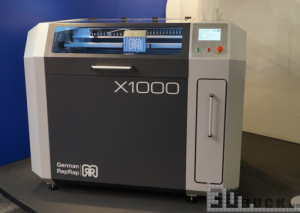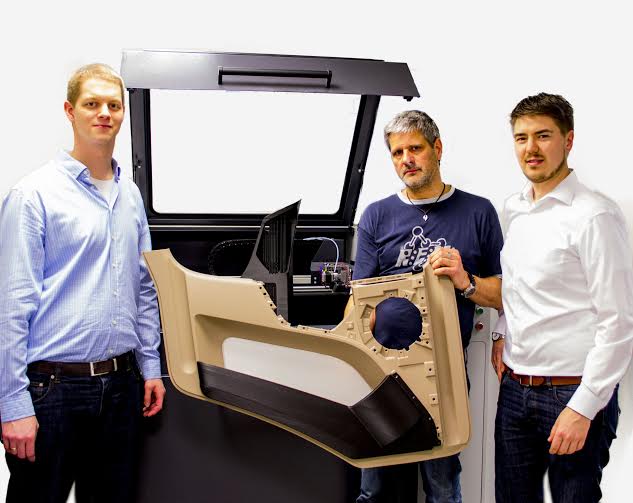 We’ve heard from numerous companies who rave about German RepRap. The company’s industrial 3D printers have been used for prototyping everything from computer mice to breast prostheses to helicopter windshield wipers, and satisfied clients all tend to say the same thing: German RepRap’s printers have dramatically cut down on the time, cost, and materials required to develop parts that previously would have taken weeks, not to mention a great deal of money.
We’ve heard from numerous companies who rave about German RepRap. The company’s industrial 3D printers have been used for prototyping everything from computer mice to breast prostheses to helicopter windshield wipers, and satisfied clients all tend to say the same thing: German RepRap’s printers have dramatically cut down on the time, cost, and materials required to develop parts that previously would have taken weeks, not to mention a great deal of money.
 Back in September, German RepRap released the second iteration of their massive industrial 3D printer, the X1000. The printer’s giant build envelope of 1000 x 800 x 600 mm has made it an invaluable piece of equipment for manufacturing companies who need to print extra large components, and who need to print them fast. TAKATA PlasTec is a major supplier of prototypes for the automotive industry, particularly plastic components such as door panels, interior and exterior trim, and safety features. TAKATA provides prototypes for original equipment manufacturers (OEM), who in turn use the prototypes to manufacture parts for automotive companies.
Back in September, German RepRap released the second iteration of their massive industrial 3D printer, the X1000. The printer’s giant build envelope of 1000 x 800 x 600 mm has made it an invaluable piece of equipment for manufacturing companies who need to print extra large components, and who need to print them fast. TAKATA PlasTec is a major supplier of prototypes for the automotive industry, particularly plastic components such as door panels, interior and exterior trim, and safety features. TAKATA provides prototypes for original equipment manufacturers (OEM), who in turn use the prototypes to manufacture parts for automotive companies.
Since they’re essentially the first link in the manufacturing chain, TAKATA needs to produce prototypes quickly and inexpensively so that their clients can proceed. Like so many other companies, they found that 3D printing has allowed them to keep up with demand much more easily and cost-effectively than other manufacturing methods. It’s also enabled them to expand the range of parts they can create.
“The costs for the external value added are reduced and it is now possible to create parts which were previously unjustifiable due to the prohibitively high costs involved,” said Kevin Rogers, manager of Application Engineering at TAKATA PlasTec.
German RepRap’s x1000 has proved to be particularly effective because of its size. Printing large components is always a challenge in terms of both time and logistics, but the x1000’s huge build envelope allows for parts to be arranged in a way that several can be printed at once, reducing the printer’s run time and improving the quality of the results.
“The X1000 is the first printer that is optimized for industrial use and covers the dimensions required for TAKATA components,” said Florian Bautz, CEO of German RepRap. “Our many years of experience in the field of 3D printing has certainly helped here and we are pleased that TAKATA has chosen our X1000.”
I haven’t heard a complaint about German RepRap yet–just case study after case study from pleased customers. The company continues to churn out new printers, as well as new models of their established printers, on a very regular basis, so I expect the successful case studies will continue as well. Discuss in the German RepRap’s x1000 3D Printer forum over at 3DPB.com.
Subscribe to Our Email Newsletter
Stay up-to-date on all the latest news from the 3D printing industry and receive information and offers from third party vendors.
You May Also Like
NSF Awards Kentucky $1M for Advanced Manufacturing
The National Science Foundation has awarded a $1 million grant to the University of Louisville for the Advancing Manufacturing and Building Construction Technologies (NSF AMT) project. This initiative is part...
3D Printing News Briefs, May 11, 2024: 3D Printed Stent, Tower, Sculptures, & More
We’re starting off with medical research in today’s 3D Printing News Briefs, as researchers in Korea used CT images and 3D printing to fabricate an educational simulator for a mastoidectomy....
3D Printing Unpeeled: Wind Turbines, Probiotics and Lenses
TPI Composites, ORNL and Ingersoll Rand are working to make wind turbine tooling segments that can be 18.3 meters long. These elements also include resistive wires that help keep the...
Tethon 3D Releases Cost-effective Bioprinter
Tethon 3D, known for its ceramic-loaded DLP materials, custom resins, and DLP 3D printers, has recently released a bioprinter. Vat polymerization printers like DLP systems have been widely used by...

































